[Alaina takes us along on a performance piece adventure through Philly, where she encounters a doctor, an astronaut, a historical figure, and a clown, among other characters. — the Artblog editors]
OK, I’m early, but I was just trying to follow directions.
The materials for Experiment #39, from the New York City-based Institute for Psychogeographic Adventure (IPA), which ran for two sold-out days on September 6 and 7 as part of this year’s Presented Philadelphia Fringe Festival, warned all comers to be 10 minutes early for their spot on this very unconventional outdoor walking performance, put on for just one or two adventurers at a time. If you’re not punctual, IPA repeatedly warned, your slot would be given to someone else.
Off to a rough start
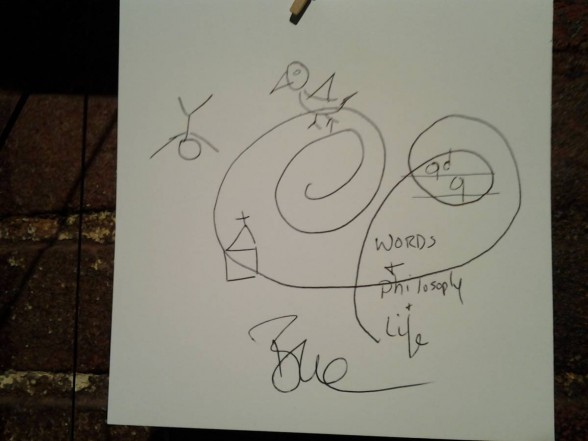
The show promises that I will “see Philadelphia in a whole new light,” and after my rather typical bus journey to IPA’s Old City headquarters for the show, in which one man agitates the entire vehicle by accusing another man of stealing a dollar, and loudly voices his desire to shoot the alleged thief with a pistol, I’m ready for a new perspective on my city.
I arrive at the IPA address on Market Street at 11:50am for my 12:15 appointment (who doesn’t try to allow extra time, with SEPTA?). The place looks like a tiny travel agency lined with waiting customers. Staffers (doctors?) in white coats and turquoise scarves sit behind some desks.
A woman wearing bright red lipstick frostily informs me that I am “very early.”
“You’ll need to come back at 12:15,” she says.
Someone calls my name from the chairs. It’s one of the Fringe Festival promoters, who helped to book my coverage.
“They’re already messing with us!” She sounds apologetic.
So I return to the steaming Saturday and sit on a stone bench by the Christ Church dog park, where a fat, buff-colored Pekingese carries a biscotti in its mouth with admirable self-discipline.
At 12:15 on the dot, I return, and receive a clipboard that looks like a new patient intake form. But the questions are a little strange: what’s my “spiritual age”? (30.) Am I past, present, or future-oriented? (Present.) Am I afraid of heights? (Yes.) If I could go hot-tubbing with one American historical figure, who would it be? (Alice Paul.)
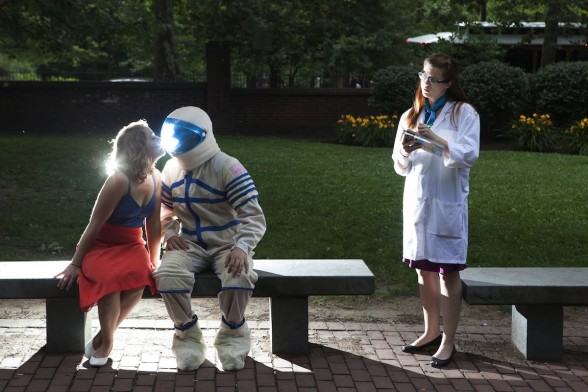
Then, a formal but friendly white-coated lady introduces herself as Liza, takes my clipboard, and leads me down a narrow staircase to a cluttered basement with one red chair and a historical plaque celebrating Johann Nepomuk Maelzec.
During our interview, the combination of our awkward isolation, the white coat and clipboard, the unpredictable personal questions and note-taking (“Do you ever feel presences?” she asks; “Presences of what?” I reply) prove painfully reminiscent of time spent at the mercy of real MDs (should psychiatric patients be entitled to trigger warnings?).
The adventure begins
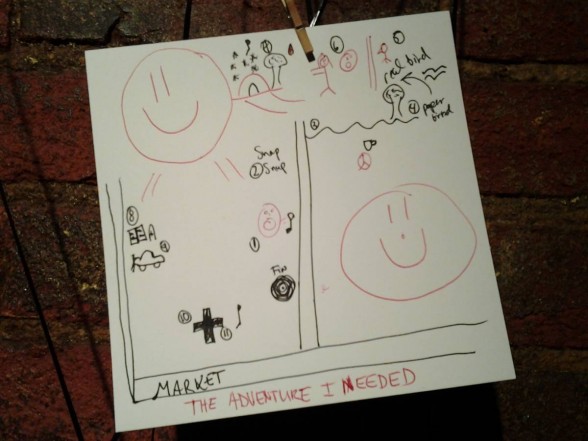
Liza asks if I’d rather have the adventure I want, or the adventure I need.
It begins with a short stroll west on Market Street, led by an actor in a neon orange jumpsuit. We discuss neighborhood history and whether or not Ben Franklin would have liked 7-11. (Certainly; the man knew how to party. He wouldn’t have said no to 24-hour Slurpee access.)
On the edges of Independence National Historic Park, a young woman in a shady arbor trellis takes me. She has a magnificent old typewriter and draws me into questions about my childhood home, listening with apparent deep interest to a true story about the time our family cat was accidentally walled up inside a remodeled bathroom. She pushes me to outline a life-sized map of the events in the surrounding area, until she waves me across the street to meet a costumed Octavius Valentine Catto–an ardent voting-rights activist from the mid-to-late 19th century, who will soon be the first African-American historical figure honored with a statue by the City of Philadelphia.
Catto and I pass Carpenters’ Hall before he waves me on to an astronaut sitting on a park bench near the south side of John Haviland’s pillared Second Bank of the US.

The astronaut, behind the bubble of her mask, doesn’t speak, but does a kind of bouncing slow-motion gallop as if gravity has decreased. Through gesture, she enthuses over a trashcan, a tree, and the steps of the bank. She picks up a discarded cigarette butt in a plastic bag and hands it to me. She sends me across 5th Street, where I am apparently expected at dinner.
Inside the American Philosophical Society, a docent named Alex offers a private lecture on a mastodon skeleton that once graced the building thanks to a New York excavation funded by Thomas Jefferson, and the politicians who held candlelit dinners inside the beast’s gargantuan ribcage.
The adventure continues along Chestnut Street, including a brief interlude with an amorous woman in the lobby of the Hotel Monaco, among the swirl of a bridal party wedging themselves past the bride’s petticoats into a white Hummer limo. A small, silent woman wearing a red clown nose meets me nearby.
Turning the pages of a pre-written notebook to communicate with me, she takes off her damp and floppy straw fedora and puts it on my head. She produces a plate, knife, fork, and bag of red grapes. She cuts a single grape in half and we share it. She gleefully pulls me to shuffle with her all the way around the revolving door of the Cosi at 4th and Chestnut.
“Don’t play in our door, please,” snaps a Cosi employee, talking on her cell phone during her break on the porch there.
Dolefully, the clown shows me the next page of her notebook, which asks what the point of life is without joy.
Over the next half-hour, I write a postcard to a fellow ticket-buyer I will never meet, in the company of a sweaty young backpacker; and enjoy a musical spoken-word performance, laced with the earthy smell of fallen leaves, incense, and the food from City Tavern, as three beautiful “Feministics” usher me along the alley that borders the north side of the restaurant.
“Can you dig it?” they sing. Yes, I can. “We thought you would,” they say approvingly.
We cross 2nd Street to dance with a pair of Mummers in full sequined regalia, and then a young man in a sleek white pedicab takes me on a short ride east to Front Street and then back to 2nd along a cobbled alleyway. He suggests that I get out, go into the AKA Music store, and ask for Michael Jackson’s Thriller on vinyl.
A bearded clerk waves me to the back of the store, where IPA scientists in white coats administer chocolates, bottles of water, and square white cards to several of my fellow travelers who have also just arrived.
Drawing my own map
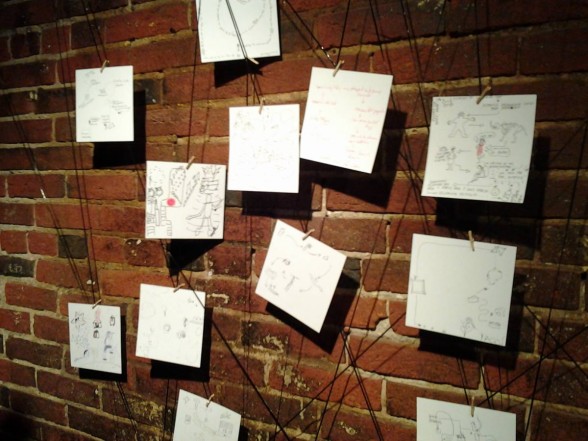
Can I draw a “psychogeographic map” of my adventure, and display it on the wall alongside the others?
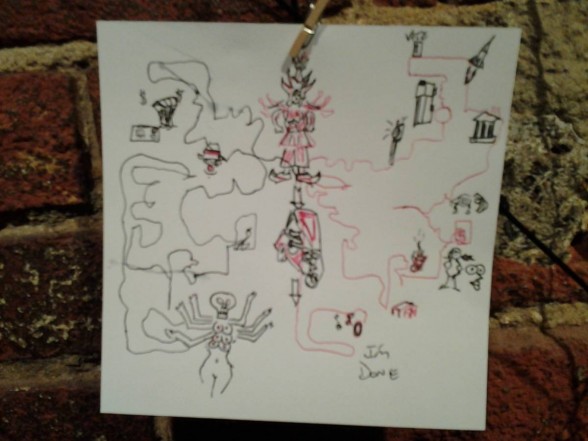
Shaky and nauseated, my total disinterest in the chocolate makes me realize I’m flirting with heat exhaustion, but I oblige, sketching the characters from my journey and gulping a bottle of warm water. It occurs to me that none of the performers I encountered released me at a crosswalk, and also that I got across all the roads safely anyway.
I’m curious about other Experiment #39 journeyers, some who went in pairs, and some who went alone, like I did. Many of them saw different performances. What were they like? I’ll never know.
Those lucky enough to experience Experiment #39, for all its white coats and pseudo-scientific weirdness, wandering through traffic, lust for you and for life, and tourists’ curious looks, got a taste of one of the Fringe Festival’s quintessential opportunities, as tightly plotted and orchestrated as it was sprawling and unexpected.
I don’t regret arriving early.
For the full lineup and more information about the Fringe Festival, running through September 21, 2014, visit the FringeArts website.









